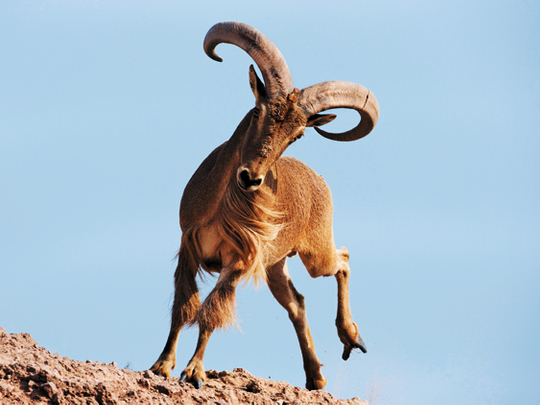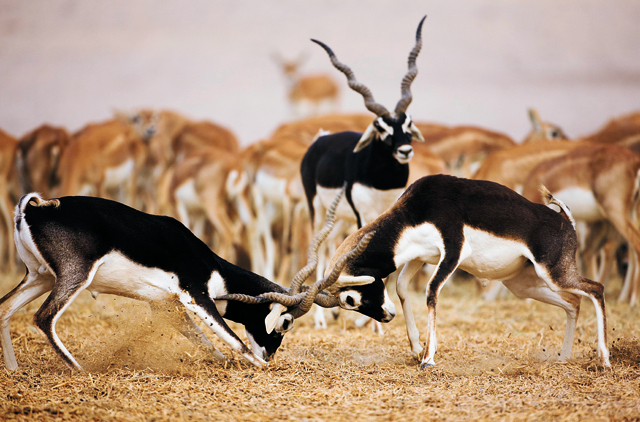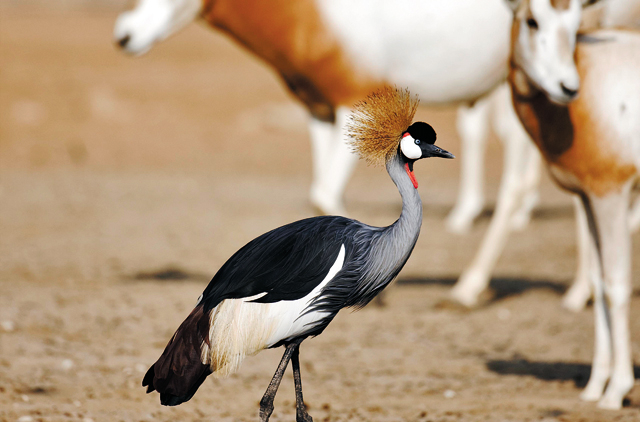
Conservation lovers have reason to celebrate. In January this year, four cubs were born to Safira, a resident cheetah, on Sir Bani Yas Island, a nature reserve off Abu Dhabi which is a major attraction for wildlife enthusiasts.
Three cubs survived, and together with the one female cheetah, Safira, from the Wildlife Centre in Dubai and two adult males from the Sharjah Breeding Centre, the cheetah population in the UAE now stands at six.
In February, two cubs were born to striped hyenas Phiri and Arnold on the island. Both the cheetahs and the striped hyenas are indigenous to the Arabian Peninsula and figure prominently on the International Union for Conservation of Nature's (IUCN's) red list, which deals with species of plants and animals that are on the brink of extinction.
The idyllic Sir Baniyas Island lies about 250km southwest of mainland Abu Dhabi, close to Jebel Dhanna. At 87 square kilometres, it is the largest natural island in the UAE. Together with the Dalma, Discovery and five other natural islands it forms the Desert Islands project which is being developed as an economic and ecological conservation centre that will provide a fiscal boost to the Western Region of Abu Dhabi.
The late Shaikh Zayed Bin Sultan Al Nahyan recognised the need for conservation of the fast-disappearing plant and animal species of the country as soon as he assumed office of the president. He had observed: "We shall continue to work to protect our environment and our wildlife as did our forefathers before us."
In 1971, Shaikh Zayed transformed the island into a private wildlife reserve to ensure the survival of the most endangered species on the Arabian Peninsula such as the Arabian Oryx, sand gazelle, cheetah and hyena. The Arabian Wildlife Park was officially opened to the public in 1990. Intensive conservation work and ecological investment have made this island home to thousands of large, free-roaming animals, including the region's largest herds of the Arabian Oryx.
The 4,100 hectares of the Arabian Wildlife Park houses 4,500 animals of a variety of species today that are both indigenous and non-indigenous to the Arabian Peninsula. Flora too was given due importance. Over a million plants of indigenous species have been grown on the island since 1971 to give it a green cover and create a natural habitat for the wild animals.
The main aim of the Wildlife Park is to create a natural ecosystem with predators and prey at the park and gradually rewild indigenous animals bred in captivity (reintroduce such creatures to their natural habitat), says Aimee Cokayne, chief research and conservation officer of the island.
Monitoring their natural lifestyle
The island's breeding programmes are not designed to interfere with the natural lifestyle of animals. The island staff play the role of monitor. Cokayne says, "We let the animals naturally mate and breed on their own in the wild. We monitor them during their reproductive cycles and conduct a census twice a year. For instance, the months of March and April are the peak season for sand gazelles and oryx births and we keep an eye on these and record them.
"The cheetahs, on the other hand, reproduce at different times of the year following a different reproductive cycle," says Cokayne. They have a gestation period of 90 to 95 days and can have one to six cubs at a time. The cheetah breeding programme on the island is integrated with the European Endangered Species Programme (EEP) and the European Association of Zoos and Aquaria (EAZA). We brought Safira from Shaikh Butti Al Maktoum's Wildlife Centre in Dubai and the two adult males - Gibbs and Gabriel - came from the Sharjah Breeding Centre. We simply provide the habitat and allow them to hunt and mate naturally as our goal is to rewild them completely."
The cheetahs play a very important role in being the natural predators on the island and control the population of the herbivores. In order to monitor them, the adult cheetahs were fitted with radio collars to track their movements. Safira successfully mated with Gabriel and gave birth to four cubs in a cave in the mountains on the island in January. She was left to care for her cubs unaided by humans and the radio collar gave the park conservation officers an excellent opportunity to study cub behaviour. "We want to reintroduce these animals to their instinctive behaviour," she adds.
A variety of breeding programmes tailored to meet the needs of individual species are in progress on the island, aimed at bringing native species back from the brink of extinction. One of the most successful programmes was that of breeding the endangered Arabian Oryx. The oryx was declared extinct by the IUCN in 1972. The breeding programme for the oryx, which began in 1970, was so successful that today there is a herd of 400 oryx on Sir Bani Yas Island alone which is regionally recognised for playing an integral part in rehabilitating this species.
Four-phase programme
The island's programme is carried out in close cooperation with the Abu Dhabi Environment Agency (ADEA). Together they have launched a specific four-phased breeding project which includes:
- Phase One Relocation of more than 10,000 animals from the island to the mainland. Many of these animals now roam free in a new 9,000 square kilometres nature sanctuary in the Liwa Desert in Al Gharbia, the Western Region of Abu Dhabi.
- Phase Two Separation of the indigenous and non-indigenous wildlife with the creation of the Arabian Wildlife Park. This programme is ongoing.
- Phase Three Introduction of predators in the wild that will encourage natural selection and ensure the strongest animals survive and breed. It is under this programme that the cheetahs and hyenas - that were both part of the Arabian Peninsula - have been allowed to mate and breed naturally.
- Phase Four Ongoing release of the animals from the Arabian Wildlife Park back into the mainland and reintroduction of new Arabian species to the Arabian Wildlife Park.In order to ensure that this take places smoothly, the park-monitoring officers are continuing to relocate non-indigenous animals such as the emu, gemsbok, eland, blackbuck and other animals. More and more water holes and grass pastures are being created to allow the animals to have a more dynamic natural habitat. The park has tied up with international breeding programmes such as the EEP and EAZA to bring the park in line with international issues of conservation of endangered species. Visitors to the park have a great educational opportunity and are able to watch the progress of the breeding programmes at close quarters, enjoy the nature retreat, indulge in many nature sports such as mountain biking, kayaking, snorkelling and nature drives. At the same time they should take measures not to pollute the environment.
The island authorities have taken several precautionary steps such as restricting the speed limit of vehicles to 50km/h, (which is less than the running speed of the slowest animal on the island); keeping certain areas out of bound to the general public, and prohibiting littering.
The staff go the extra mile to clear any rubbish when they come across it, be it on land or the coast. The authorities also take all steps to tend to a sick or injured animal at the earliest to ensure better chances of survival. Moreover, there is an interesting programme whereby a single mangrove shrub is planted for every new visitor coming to the island. This, it is hoped, will help offset the environmental impact by man.
Mangrove shrubs and trees of the species Avicennia Marina (Grey Mangrove) occur naturally along the coastline and are extremely beneficial in creating protected areas for the fish to breed, removing carbon dioxide from the water and preventing coastal erosion.
With all the programmes and activities in place Sir Bani Yas Island is taking care to realise the vision of Shaikh Zayed in making the place a true sanctuary for indigenous species of plants, animals and birds. It is truly a celebration of nature in its complete glory. The island is accessible by air, sea and road. For information on the conservation programme, log on to www.desertislands.com
SOME SPECIES ON THE ISLAND
Among the species of animals on the island are:
- The Arabian Oryx
- The Arabian mountain gazelle
- The Arabian hare
- Jerboa
- Hedgehogs
- Gerbils
- Barbary sheep
- Beisa oryx
- Blackbuc
- Cheetah
- Eland
- Flamingo
- Gemsbok
- Giraffe
- Ostrich
- Striped hyena
- Sand gazelle
- digenous and non-native bird species, such as eagles, falcons, flamingoes, cormorants, pintails, crab plovers, grey herons, avocets and teals.
Besides these, since the Island is located in a major non-fishing zone, the surrounding waters are also frequented by large numbers of dugongs, dolphins and sea turtles.




